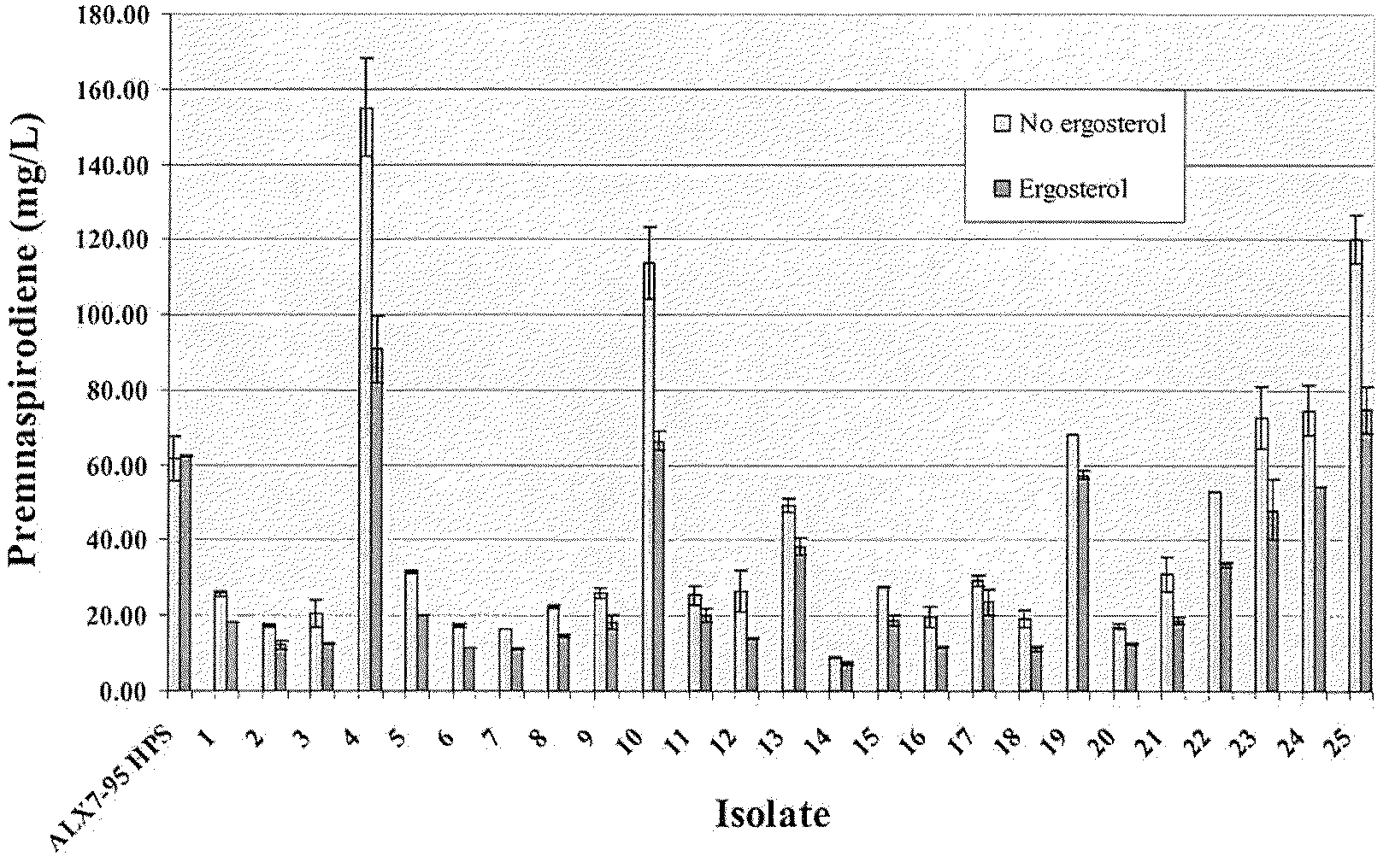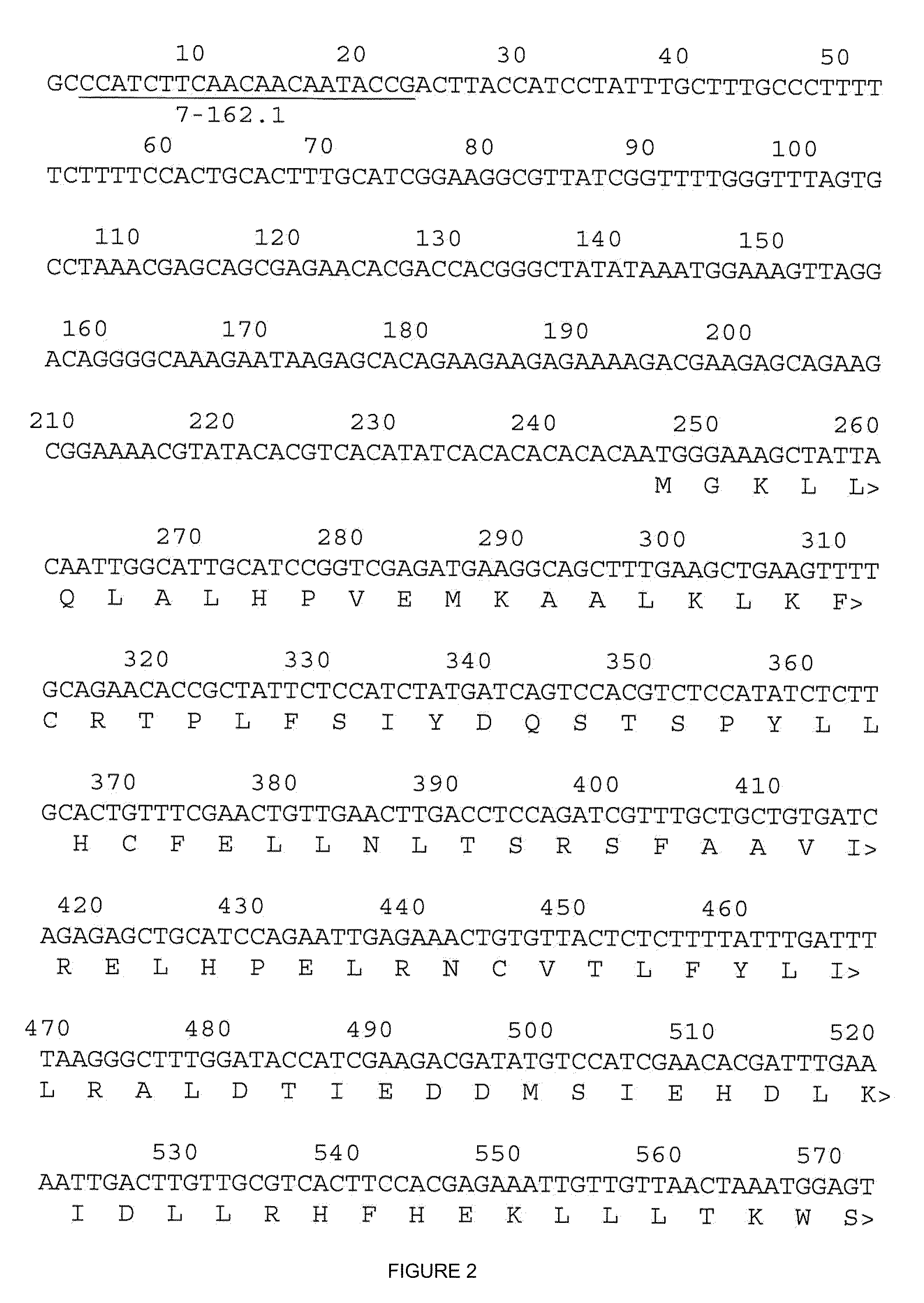Method for production of isoprenoids
a technology of isoprenoids and isoprenoids, which is applied in the field of yeast strains to achieve the effects of reducing activity, high rate and reducing activity
- Summary
- Abstract
- Description
- Claims
- Application Information
AI Technical Summary
Benefits of technology
Problems solved by technology
Method used
Image
Examples
example 1
Generation of Mutant ERG9 Genes
[0170]Chromosomal DNA isolated from Saccharomyces cerevisiae strain ATCC28383 was used as the DNA template for PCR amplification of the wild type ERG9 gene. The primers used for the amplification were the upstream primer 7-162.1 5′-CCATCTTCAACAACAATACCG-3′ (SEQ ID NO: 1) (underlined nucleotides at the 5′ end of the ERG9 sequence in FIG. 2) and the downstream primer 7-162.2 5′-GTACTTAGTTATTGTTCGG-3′ (SEQ ID NO: 2) (underlined nucleotides at the 3′ end of ERG9). Using Taq polymerase (New England Biolabs), amplification conditions were 94° C. for 30 seconds, 45° C. for 30 seconds, 72° C. for 2 minutes for a total of 30 cycles. The resulting ERG9 PCR product was sequenced and verified to be identical to the published sequence for ERG9. This DNA was used as the template for performing error prone PCR using the GeneMorph kit from Stratagene and the same primers described above. The error-prone PCR reaction was run using two different DNA concentrations (˜500...
example 2
Isolation of Erg9def Mutants
[0171]To isolate ERG9 mutants that make sufficient ergosterol to restore growth, the PCR product from the mutagenic PCR reaction was transformed into ALX7-95 (his3, trp1, erg9::HIS3, HMGcat / TRP1:rDNA, dpp1), a leucine prototroph of strain CALI-5 (U.S. Pat. Nos. 6,531,303 and 6,689,593), containing a plasmid expressing the Hyoscyamus muticus premnaspirodiene synthase (HPS) gene. The HPS gene was cloned into the yeast shuttle expression vector YEp-GW-URA-NheI / BamHI to give YEp-HPS-ura. This vector contained the ADH1 promoter for initiating transcription of the HPS gene. In addition, it contained the ADH1 terminator downstream of the HPS gene. This vector was maintained in S. cerevisiae by selecting media lacking uracil and it was maintained in E. coli by selecting for resistance to ampicillin.
[0172]Transformation procedure of this strain with the ERG9 mutant pool used the lithium acetate transformation kit from Sigma. Transformants were selected for growth ...
example 3
Production of Premnaspirodiene in Fermentors
[0175]As described in Example 2, strain ALX7-175.1 was constructed for the production of premnaspirodiene. Production of premnaspirodiene in this strain was compared to that of strain ALX7-95 HPS, which is completely lacking in squalene synthase activity.
[0176]Production of premnaspirodiene was carried out in a 3-L fermentation tank (New Brunswick Bioflow 110). One liter of fermentation medium was prepared and autoclaved in the fermentation tank (20 g (NH4)2SO4, 20 g KH2PO4, 1 g NaCl, MgSO4.7H2O, 4 g yeast extract (Difco). Afterward the following components were added: 20 ml mineral solution (0.028% FeSO4.7H2O, 0.029% ZnSO4.7H2O, 0.008% CuSO4.5H2O, 0.024% Na2MoO4.2H2O, 0.024% CoCl2.6H2O, 0.017% MnSO4.H2O, 1 mL HCl); 10 mL 50% glucose; 30 mL vitamin solution (0.001% biotin; 0.012% calcium pantothenate, 0.06% inositol, 0.012% pyridoxine-HCl, 0.012% thiamine-HCl); 10 mL 10% CaCl2, and 20 mL autoclaved soybean oil (purchased from local groceri...
PUM
| Property | Measurement | Unit |
|---|---|---|
| Volume | aaaaa | aaaaa |
| Volume | aaaaa | aaaaa |
| Mass | aaaaa | aaaaa |
Abstract
Description
Claims
Application Information
 Login to View More
Login to View More - R&D
- Intellectual Property
- Life Sciences
- Materials
- Tech Scout
- Unparalleled Data Quality
- Higher Quality Content
- 60% Fewer Hallucinations
Browse by: Latest US Patents, China's latest patents, Technical Efficacy Thesaurus, Application Domain, Technology Topic, Popular Technical Reports.
© 2025 PatSnap. All rights reserved.Legal|Privacy policy|Modern Slavery Act Transparency Statement|Sitemap|About US| Contact US: help@patsnap.com



